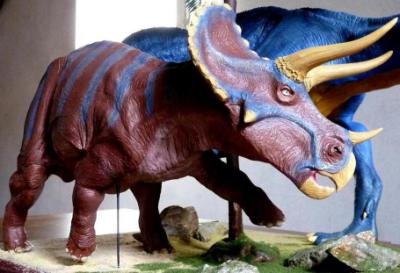Welcome - I hope you enjoy viewing my work. I modify most of my figure kits so that they wind up quite different from the original. (And there is a lot more here than just dinosaurs - so browse on!) I re-discovered the joy of art in mid-life and its been a joy to create and share my vision with others. Art, like all creative gifts, exists to be shared so as to enrich the lives of others.
So this website is my gift to you. If you have an interest in art/sculpting/modeling of all kinds of subjects, I would recommend that you check out the Internet Figure Modeling Clubhouse at
INTERNET CLUBHOUSE and also see
At both sites you will find incredible artists and sculptors, some nationally known. Their work will leave you in awe.
Thank you for stopping by!
NAVIGATION INSTRUCTIONS: THE GALLERY PAGE LINKS ARE THE SMALL NUMBERS ON THE LEFT, JUST ABOVE THE INDEX PHOTOS. TO ENLARGE PHOTOS, CLICK ON THE THUMBNAIL, THEN CLICK ON THE ENLARGED PHOTO IN THE LOWER RIGHT-HAND CORNER OF THIS PAGE AND FOLLOW THE DIRECTIONS.
FYI: SOME THUMBNAILS MAY APPEAR DISTORTED - IF YOU CLICK ON THE "VIEW FULL SIZE IMAGE" TEXT ON LOWER R OF THE PHOTO IT WILL OPEN UP CORRECTLY.
The Darga Triceratops was customized by repositioning all four legs to give the animal a more dynamic, upright pose. The tail was also shortened and straightened out.
Triceratops horridus
Pronounced: try-Sair-o-tops Diet: Herbivore (Plant-Eater) Name Means: "three horn face" Length: 28 feet (9 m) Height: 8 feet (2.7 m) Weight: 7 tons (12,000 kilos) Time: Late Cretaceous - 65 MYA
One of the top three on everyone's favorite dinosaur list, Triceratops is a very common dinosaur which lived at the very end of the Age of Dinosaurs. It had a huge frilled head with horns over each eye that could reach over 4 feet long. Triceratops had a third, smaller horn on its nose. These would be fearsome weapons against a predator.
Triceratops is one of the most common dinosaur fossils found. More than 50 skulls have been found. Within the genus, at least 7 species have been identified. The ceratopsian family is one of the most successful and varied of the Late Cretaceous. Triceratops is the largest member of this family, reaching the size of a school bus.
Triceratops was a herd animal; it is believed that large groups roamed North America. Their large, horny beaks and long rows of teeth were well designed for chewing the tough, low growing plants of the Late Cretaceous. It was likely the main predator of these animals was T. rex. A number of skeletons show bite and chew marks that match the teeth of T. rex. Horns and frills seemed to vary among individuals within the species. Some frills were very broad, others narrow. The nasal horn shows the most variance among individual specimens, no two being the same. The material that covered its horns in life would have added significantly to the length of the fossilized bone.








